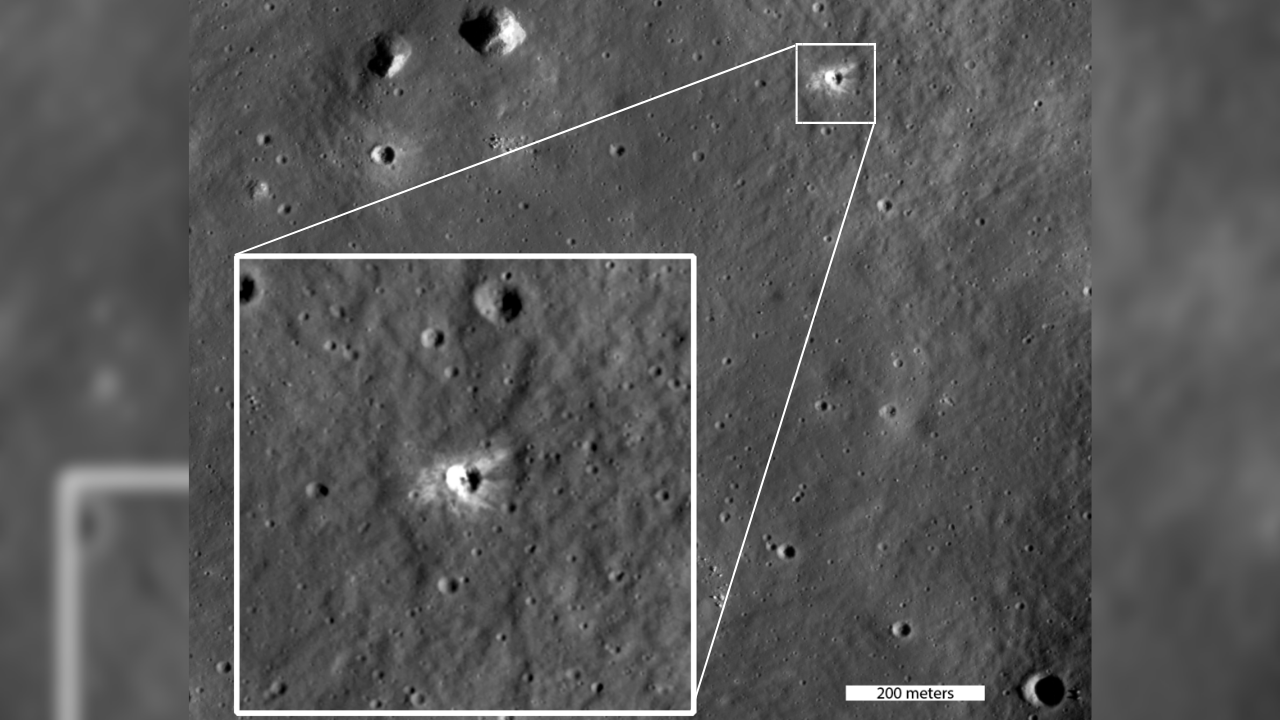Scientists just discovered a new crater on the moon — they call it a 'freckle'
NASA's moon orbiter has found another lunar dent.

The headline says it all: The list of our moon's craters just got a little longer.
On Nov. 13, the Lunar Reconnaissance Orbiter Camera (LROC) team — which operates visual equipment on NASA's Lunar Reconnaissance Orbiter (LRO) — announced the discovery of a never-before-seen dent in Earth's natural satellite. It appears to be about 72 feet (22 meters) in diameter, probably formed between December 2009 and December 2012 and comes from a collision scientists say happened just north of another lunar cavity, Römer crater.
What's important to keep in mind, though, is that finding new craters on our moon isn't really a new thing for LROC. One of its capabilities is to perform temporal analyses, which essentially means comparing before-and-after pictures of the same section of the lunar surface as seen from orbit. Indeed, this strategy has led to LROC discovering quite a few new impact craters on our planet's companion. This has, in fact, been a big deal, because it proved to us that the moon's surface is dynamic even on a human timescale.
For instance, as of a 2016 statement from the LROC team, scientists had found over 200 impact craters that formed during the LRO mission (which began in 2009). In 2023, the moon-orbiting probe even found a possible human-made crater — the consequence of Russia's Luna 25 lunar lander crashing into the world's surface.
The scoop on a new crater
As for this latest crater discovery, the team says what we know so far about the subject is that it ejected bright material tens of yards from the crater rim upon impact, and that this ejection yielded "sunburst-shaped" rays. Similar sorts of rays have been seen near fresh lunar craters before, such as with this impact from March 17, 2013.
"Over time, the rays will darken to the shade of the surrounding regolith as the material is exposed to space weathering," the LROC statement reads.
It's also notably small, as the team refers to it as a "freckle" on the moon.
Breaking space news, the latest updates on rocket launches, skywatching events and more!
Finding new craters on the moon is "essential for understanding impact rates and crater degradation rates over time, as well as for planning safe, successful missions to the moon," the statement adds.
The latter point is particularly important, as several nations are racing to get boots back on the moon, including NASA. NASA's Artemis moon program, presently slated to roll out over the next decade, intends to land humans on the moon for the first time since 1972. As a result, scientists have been meticulously trying to learn about the safety of the selected landing zone, a large region near the moon's south pole. For instance, you have to take into consideration how good communication with Earth will be from a certain location, what the general terrain is like and what lighting conditions might be, as shadows on the moon can be tricky. Some experts are even taking into consideration seismic conditions (moonquakes, basically).
So, presumably, a landing zone with an unexpected crater could spell disaster for such a mission. The more we know about our moon's dented body, the better.

Monisha Ravisetti is Space.com's Astronomy Editor. She covers black holes, star explosions, gravitational waves, exoplanet discoveries and other enigmas hidden across the fabric of space and time. Previously, she was a science writer at CNET, and before that, reported for The Academic Times. Prior to becoming a writer, she was an immunology researcher at Weill Cornell Medical Center in New York. She graduated from New York University in 2018 with a B.A. in philosophy, physics and chemistry. She spends too much time playing online chess. Her favorite planet is Earth.
You must confirm your public display name before commenting
Please logout and then login again, you will then be prompted to enter your display name.
